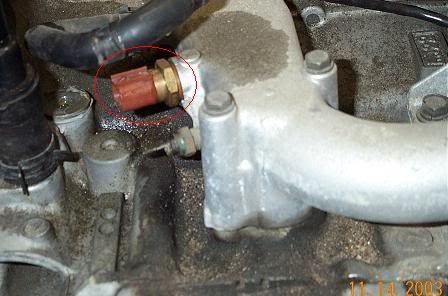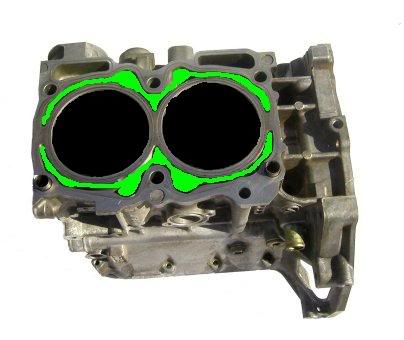On Subaru cars there are a lot of problems that could happen to your cooling system. Head gasket failure is probably the biggest and least understood problem that comes up on RS25 at least once a week. So I am taking it upon myself to create a Cooling System Write-Up. I will try to list and explain all components of your cooling system and how critical they are to your car. I’m hoping it will give people a better understanding of their cooling system and help them diagnose their own problems in the future. Hopefully I don't crash and burn.
First things first. I recommend only Genuine OEM Subaru Parts. OEM parts were designed specifically for our cars. They fit perfectly. They are designed to the exact tolerances and specifications. There is no substitute for OEM quality. I have heard to many stories about people buying aftermarket parts and having them not fit correctly, not work properly, and cause more problems than what the owner had before. In my opinion, it's just not worth the hassle. But if you are upgrading to a high quality performance part, go for it!
Coolant: Subaru recommends using their own Genuine Long Life Coolant/Antifreeze in all Subaru vehicles. According to Subaru, this genuine coolant contains antifreeze and anti-rust agents that are especially designed for the Subaru engine. Primarily because of its aluminum crankcase. They claim that other coolants may cause corrosion within the Subaru engine. They also do not recommend using any additional anti-rust and corrosion inhibitors.
Color of Genuine Subaru Coolant (SOA868V9210 or SOA635002) is a darker forest green. It is far from the normal neon green antifreeze that is commonly bought at your local parts store. Also when mixed 50/50 with water, it is thicker than any other coolant on the market. It has an extremely sweet smell to it as well.
Also Subaru recommends running the new Cooling System Conditioner (SOA635071) in all Phase II EJ25 engines. Due to a poor design in initial head gaskets, internal and external coolant leaks may occur. They recommend adding 1 bottle of the conditioner every time you have the cooling system serviced. Never add this product to the coolant reservoir. Always remove coolant from the radiator and add the bottle straight into the radiator. Then top the radiator off with coolant until full.
![Image]()
Water: Subaru recommends using pure tap water when mixing your coolant. And since pure tap water doesn't exist, Distilled water is the next best thing. Tap water or spring water contains many minerals that can form deposits within your cars cooling system. Over time they will deteriorate your cooling systems capabilities to keep your engine at optimal operating temperature. Deposits can plug your radiator, heater core, thermostat, and other areas of your cooling system that has small passages.
Ok, your cooling system is consists of your radiator cap, radiator, radiator hoses, thermostat, thermostat housing, water pump, passages through your engine block and cylinder head, head gasket, coolant temperature sensor, heater hoses, and a heater core.
Your cooling systems main function is to reduce heat within the engine. A normal combustion chamber will experience temperatures from 1500-4000 degrees F. Normal operating temperatures for a Subaru are 158-212 degrees F. So as you can see, there is a lot of heat that the cooling system needs to get rid of. And only a properly functioning and well maintained cooling system will due.
There are a lot of different problems that can arise within a cooling system. So I will break them down by individual component and try to explain why things happen the way they do.
Radiator cap – The function of the radiator cap is to let pressure build within the cooling system to a safe level. Stock radiator caps will hold pressure up to approx. 16 PSI before it will for open the spring and release coolant into the overflow tank. The purpose of keeping the coolant under pressure is to increase the boiling point of it. The higher the boiling temperature, the more efficient your cooling system will be. When the engine is shut off and is cooling down, the radiator cap will let the coolant that ran into the overflow tank go back into the radiator to keep it full and not let any air enter the system.
When a radiator cap isn’t functioning properly numerous problems can arise.
1. If the radiator cap is stuck shut, it will raise the pressure of the cooling system considerably. In this case it is very possible to have a radiator hose burst or even have the radiator burst as well. Any pressures over 16 PSI can be fatal to cooling system components.
2. If the radiator cap is stuck open, it will cause overheating problems. Without having the cooling system properly pressurized, the coolant will boil over into the overflow and not be as efficient as it should be. This will raise the coolant temperature and cause your car to overheat.
3. If a radiator cap is not opening properly during the engine cool down, it can cause radiator hoses to collapse. Pressure is built within the hoses whenever the temperature is hot and the coolant is expanded. Once the coolant cools, it will try to suck extra coolant into the system through the radiator cap. If the cap does not open and allow that coolant to flow, the hoses will pull a vacuum and collapse. If this happens, remove the radiator cap and you will find the hose will “inflate” again.
4. A stock radiator cap is designed to only hold 16 PSI of pressure. The STi cap holds around 19 PSI. The extra pressure created by these caps will most likely cause radiator failure when used on a stock cooling system.
![Image]()
With any of these symptoms, it wouldn’t be a bad idea to just replace the radiator cap and give it a shot. Radiator caps are relatively inexpensive and do go bad over time. It’s probably the cheapest and easiest part to replace on your cooling system.
Radiator – Your cars radiator serves one purpose. Reduce cooling system temperatures (on AT cars, it cools the ATF temperatures as well). Your car needs to be between 158-212 degrees F to operate as efficiently as it can. So the radiator is basically a piece of pipe that is coiled in rows from the top to the bottom. Those coils are covered in fins that act as heat sinks. As the coolant passes down through the radiator, the heat dissipates from the tubing to the fins. Then as air passes over the fins, the heat is removed from the cooling system. (When the car is idling and there is no airflow across the radiator, your electric radiator fans will kick on to help remove heat from the radiator.) And if you ever touch your upper radiator hose, you will find that it’s hotter then the lower radiator hose. That’s how efficient a cars cooling system is.
![Image]()
Problems that can arise from a radiator.
1. A radiator can cause a car to overheat for several reasons. If the radiator is plugged, it won’t let the coolant circulate as fast as it needs to. When the coolant isn’t being cooled properly, heat will rise within the cooling system. Corrosion and rust are the two main reasons why radiators get plugged.
2. Also if the fins on the radiator are bent, proper airflow will not dissipate the heat as well as it should. This will also cause cooling system temperatures to rise.
3. Anytime you see coolant leaking from your radiator, have your radiator replaced immediately. NEVER trust any kind of radiator stop leak in a bottle. It will only clog up the rest of your cooling system creating more problems for you in the end.
4. Also, stock radiators can only handle up to 16PSI of pressure. By adding an aftermarket radiator cap, it’s been know to burst the radiator end tanks.
Radiator hoses – There really isn’t anything spectacular about radiator hoses. But their condition is vital to the proper functioning of your cooling system. Anytime you find a crack or bulge on a radiator hose, replace it immediately. It only takes a little bit of extra pressure to cause that hose to break and leave you stranded along side the road. Always check the condition of your radiator hoses and heater hoses during oil changes and any other under hood maintenance. And if one is bad, replace them all. They aren’t that expensive and replacing them now will save a lot of headaches down the road.
Thermostat – Your cars thermostat serves one purpose. To get your engine to operating temperature as quickly as possible. The quicker your engine gets to operating temperature, the better efficiency your engine will have. When your car is initially started, the coolant temperature is the same as the ambient air temperature outside. Your engine runs it’s best around 190-220 degrees F. So the quicker the temperature rises, the better your fuel economy will be and better performance you will get out of your engine. The idea of the thermostat is to stay closed and only leave coolant circulate in the engine until operating temperature is met. Once the coolant reaches a certain temperature, the thermostat will mechanically open and allow that coolant to circulate through the rest of the cooling system.
![Image]()
![Image]()
Problems that can arise from a bad thermostat,
1. If the thermostat is stuck shut your car will come up to operating temperature normally. But once operating temperature is met, the thermostat won’t open as it’s intended to. So your car will continue to build heat within the engine causing an overheating condition. Some times you will see your temperature gauge rise and if a worst-case scenario, you may blow a radiator hose off. Either way, it’s not good for your engine.
2. If the thermostat is stuck open, you will realize your car won’t come up to operating temperature as quick as it should. In some cases, operating temperature will never be met. You may drive your car and find that it will build up some heat, but once the car is left sitting at idle, all heat that was built up will be lost. The thermostat is letting coolant circulate through the entire cooling system at all times never allowing the engine to build up the heat that it needs to run efficiently. Any time your thermostat is stuck open, your car should never overheat. It’s acting at all times as if the engine was at operating temperature and it won’t let any heat build up.
3. Anytime you have your cooling system drained, it’s a good idea to just replace the thermostat. It’s a small price to pay for assurance that you have a new thermostat. The thermostat is located on the bottom of the engine block where the lower radiator hose enters the engine. The plastic joint that connects the hose to the engine is the thermostat housing. Just drain the cooling system and remove the 2 10mm bolts and pull the housing off. Clean all of the corrosion off of the housing and install a new thermostat with a new gasket.
Water Pump – Your water pump is the heart of your cooling system. It’s run off of the timing belt under the timing belt covers. The only part of the water pump that is visible is the bottom of it where the thermostat housing is bolted to it. Whenever your car is running, the water pump is working at all times. It circulates the coolant through the engine at all times to ensure that your coolant doesn’t build up any hot spots when the thermostat is closed. Then when the thermostat is open, it circulates coolant through the entire cooling system. There is a bypass hose off of the water pump to allow the coolant to circulate throughout the engine while the thermostat is closed.
![Image]()
Problems that can arise with the water pump,
1. The most common problem with our water pumps is that they will start to leak over time. Since your water pump goes through so much stress, over time the gasket will start to leak, seals around the pulley will start to leak, or the water pump may even crack. If you are experiencing coolant loss, look under your car where the lower radiator hose meets the water pump. If you see coolant dripping off of the housing, chances are it’s the water pump. Also as the coolant dries, it may leave a dried green crust around the thermostat housing. Anytime you see these symptoms, your water pump probably needs replaced.
2. Water pumps may start to make noise over time. Since they are always spinning at about the same RPM as the engine, the bearings within the pump will start to go bad. Normally you may hear a faint humming noise when your car is sitting at idle, but when the RPM’s are increased, the humming noise will increase with the speed of the engine. Anytime this happens, your water pump needs replaced. If the bearings are bad enough, it may cause the pulley to wobble and throw the timing belt off. This can be catastrophic to your engine.
3. Anytime you replace your water pump, it’s recommended to replace your timing belt as well. If you have the work done at a shop, there shouldn’t be any extra labor costs due to the fact that they will have the timing belt off to service the water pump. Also it wouldn’t be a bad idea to have a new thermostat and thermostat housing installed. Even new radiator hoses wouldn’t be a bad idea. This is a really good time to do a lot of maintenance to your cooling system.
First things first. I recommend only Genuine OEM Subaru Parts. OEM parts were designed specifically for our cars. They fit perfectly. They are designed to the exact tolerances and specifications. There is no substitute for OEM quality. I have heard to many stories about people buying aftermarket parts and having them not fit correctly, not work properly, and cause more problems than what the owner had before. In my opinion, it's just not worth the hassle. But if you are upgrading to a high quality performance part, go for it!
Coolant: Subaru recommends using their own Genuine Long Life Coolant/Antifreeze in all Subaru vehicles. According to Subaru, this genuine coolant contains antifreeze and anti-rust agents that are especially designed for the Subaru engine. Primarily because of its aluminum crankcase. They claim that other coolants may cause corrosion within the Subaru engine. They also do not recommend using any additional anti-rust and corrosion inhibitors.
Color of Genuine Subaru Coolant (SOA868V9210 or SOA635002) is a darker forest green. It is far from the normal neon green antifreeze that is commonly bought at your local parts store. Also when mixed 50/50 with water, it is thicker than any other coolant on the market. It has an extremely sweet smell to it as well.
Also Subaru recommends running the new Cooling System Conditioner (SOA635071) in all Phase II EJ25 engines. Due to a poor design in initial head gaskets, internal and external coolant leaks may occur. They recommend adding 1 bottle of the conditioner every time you have the cooling system serviced. Never add this product to the coolant reservoir. Always remove coolant from the radiator and add the bottle straight into the radiator. Then top the radiator off with coolant until full.
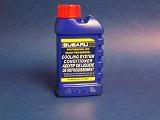
Water: Subaru recommends using pure tap water when mixing your coolant. And since pure tap water doesn't exist, Distilled water is the next best thing. Tap water or spring water contains many minerals that can form deposits within your cars cooling system. Over time they will deteriorate your cooling systems capabilities to keep your engine at optimal operating temperature. Deposits can plug your radiator, heater core, thermostat, and other areas of your cooling system that has small passages.
Ok, your cooling system is consists of your radiator cap, radiator, radiator hoses, thermostat, thermostat housing, water pump, passages through your engine block and cylinder head, head gasket, coolant temperature sensor, heater hoses, and a heater core.
Your cooling systems main function is to reduce heat within the engine. A normal combustion chamber will experience temperatures from 1500-4000 degrees F. Normal operating temperatures for a Subaru are 158-212 degrees F. So as you can see, there is a lot of heat that the cooling system needs to get rid of. And only a properly functioning and well maintained cooling system will due.
There are a lot of different problems that can arise within a cooling system. So I will break them down by individual component and try to explain why things happen the way they do.
Radiator cap – The function of the radiator cap is to let pressure build within the cooling system to a safe level. Stock radiator caps will hold pressure up to approx. 16 PSI before it will for open the spring and release coolant into the overflow tank. The purpose of keeping the coolant under pressure is to increase the boiling point of it. The higher the boiling temperature, the more efficient your cooling system will be. When the engine is shut off and is cooling down, the radiator cap will let the coolant that ran into the overflow tank go back into the radiator to keep it full and not let any air enter the system.
When a radiator cap isn’t functioning properly numerous problems can arise.
1. If the radiator cap is stuck shut, it will raise the pressure of the cooling system considerably. In this case it is very possible to have a radiator hose burst or even have the radiator burst as well. Any pressures over 16 PSI can be fatal to cooling system components.
2. If the radiator cap is stuck open, it will cause overheating problems. Without having the cooling system properly pressurized, the coolant will boil over into the overflow and not be as efficient as it should be. This will raise the coolant temperature and cause your car to overheat.
3. If a radiator cap is not opening properly during the engine cool down, it can cause radiator hoses to collapse. Pressure is built within the hoses whenever the temperature is hot and the coolant is expanded. Once the coolant cools, it will try to suck extra coolant into the system through the radiator cap. If the cap does not open and allow that coolant to flow, the hoses will pull a vacuum and collapse. If this happens, remove the radiator cap and you will find the hose will “inflate” again.
4. A stock radiator cap is designed to only hold 16 PSI of pressure. The STi cap holds around 19 PSI. The extra pressure created by these caps will most likely cause radiator failure when used on a stock cooling system.

With any of these symptoms, it wouldn’t be a bad idea to just replace the radiator cap and give it a shot. Radiator caps are relatively inexpensive and do go bad over time. It’s probably the cheapest and easiest part to replace on your cooling system.
Radiator – Your cars radiator serves one purpose. Reduce cooling system temperatures (on AT cars, it cools the ATF temperatures as well). Your car needs to be between 158-212 degrees F to operate as efficiently as it can. So the radiator is basically a piece of pipe that is coiled in rows from the top to the bottom. Those coils are covered in fins that act as heat sinks. As the coolant passes down through the radiator, the heat dissipates from the tubing to the fins. Then as air passes over the fins, the heat is removed from the cooling system. (When the car is idling and there is no airflow across the radiator, your electric radiator fans will kick on to help remove heat from the radiator.) And if you ever touch your upper radiator hose, you will find that it’s hotter then the lower radiator hose. That’s how efficient a cars cooling system is.
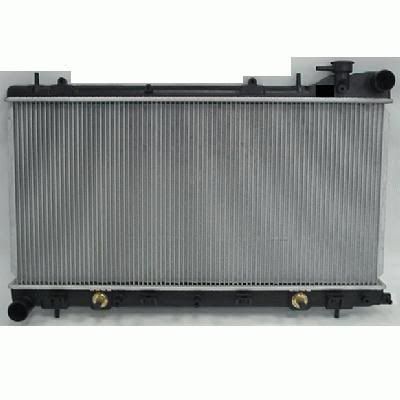
Problems that can arise from a radiator.
1. A radiator can cause a car to overheat for several reasons. If the radiator is plugged, it won’t let the coolant circulate as fast as it needs to. When the coolant isn’t being cooled properly, heat will rise within the cooling system. Corrosion and rust are the two main reasons why radiators get plugged.
2. Also if the fins on the radiator are bent, proper airflow will not dissipate the heat as well as it should. This will also cause cooling system temperatures to rise.
3. Anytime you see coolant leaking from your radiator, have your radiator replaced immediately. NEVER trust any kind of radiator stop leak in a bottle. It will only clog up the rest of your cooling system creating more problems for you in the end.
4. Also, stock radiators can only handle up to 16PSI of pressure. By adding an aftermarket radiator cap, it’s been know to burst the radiator end tanks.
Radiator hoses – There really isn’t anything spectacular about radiator hoses. But their condition is vital to the proper functioning of your cooling system. Anytime you find a crack or bulge on a radiator hose, replace it immediately. It only takes a little bit of extra pressure to cause that hose to break and leave you stranded along side the road. Always check the condition of your radiator hoses and heater hoses during oil changes and any other under hood maintenance. And if one is bad, replace them all. They aren’t that expensive and replacing them now will save a lot of headaches down the road.
Thermostat – Your cars thermostat serves one purpose. To get your engine to operating temperature as quickly as possible. The quicker your engine gets to operating temperature, the better efficiency your engine will have. When your car is initially started, the coolant temperature is the same as the ambient air temperature outside. Your engine runs it’s best around 190-220 degrees F. So the quicker the temperature rises, the better your fuel economy will be and better performance you will get out of your engine. The idea of the thermostat is to stay closed and only leave coolant circulate in the engine until operating temperature is met. Once the coolant reaches a certain temperature, the thermostat will mechanically open and allow that coolant to circulate through the rest of the cooling system.


Problems that can arise from a bad thermostat,
1. If the thermostat is stuck shut your car will come up to operating temperature normally. But once operating temperature is met, the thermostat won’t open as it’s intended to. So your car will continue to build heat within the engine causing an overheating condition. Some times you will see your temperature gauge rise and if a worst-case scenario, you may blow a radiator hose off. Either way, it’s not good for your engine.
2. If the thermostat is stuck open, you will realize your car won’t come up to operating temperature as quick as it should. In some cases, operating temperature will never be met. You may drive your car and find that it will build up some heat, but once the car is left sitting at idle, all heat that was built up will be lost. The thermostat is letting coolant circulate through the entire cooling system at all times never allowing the engine to build up the heat that it needs to run efficiently. Any time your thermostat is stuck open, your car should never overheat. It’s acting at all times as if the engine was at operating temperature and it won’t let any heat build up.
3. Anytime you have your cooling system drained, it’s a good idea to just replace the thermostat. It’s a small price to pay for assurance that you have a new thermostat. The thermostat is located on the bottom of the engine block where the lower radiator hose enters the engine. The plastic joint that connects the hose to the engine is the thermostat housing. Just drain the cooling system and remove the 2 10mm bolts and pull the housing off. Clean all of the corrosion off of the housing and install a new thermostat with a new gasket.
Water Pump – Your water pump is the heart of your cooling system. It’s run off of the timing belt under the timing belt covers. The only part of the water pump that is visible is the bottom of it where the thermostat housing is bolted to it. Whenever your car is running, the water pump is working at all times. It circulates the coolant through the engine at all times to ensure that your coolant doesn’t build up any hot spots when the thermostat is closed. Then when the thermostat is open, it circulates coolant through the entire cooling system. There is a bypass hose off of the water pump to allow the coolant to circulate throughout the engine while the thermostat is closed.
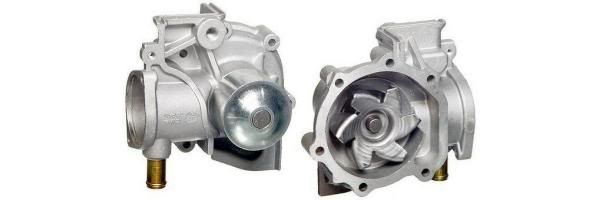
Problems that can arise with the water pump,
1. The most common problem with our water pumps is that they will start to leak over time. Since your water pump goes through so much stress, over time the gasket will start to leak, seals around the pulley will start to leak, or the water pump may even crack. If you are experiencing coolant loss, look under your car where the lower radiator hose meets the water pump. If you see coolant dripping off of the housing, chances are it’s the water pump. Also as the coolant dries, it may leave a dried green crust around the thermostat housing. Anytime you see these symptoms, your water pump probably needs replaced.
2. Water pumps may start to make noise over time. Since they are always spinning at about the same RPM as the engine, the bearings within the pump will start to go bad. Normally you may hear a faint humming noise when your car is sitting at idle, but when the RPM’s are increased, the humming noise will increase with the speed of the engine. Anytime this happens, your water pump needs replaced. If the bearings are bad enough, it may cause the pulley to wobble and throw the timing belt off. This can be catastrophic to your engine.
3. Anytime you replace your water pump, it’s recommended to replace your timing belt as well. If you have the work done at a shop, there shouldn’t be any extra labor costs due to the fact that they will have the timing belt off to service the water pump. Also it wouldn’t be a bad idea to have a new thermostat and thermostat housing installed. Even new radiator hoses wouldn’t be a bad idea. This is a really good time to do a lot of maintenance to your cooling system.


